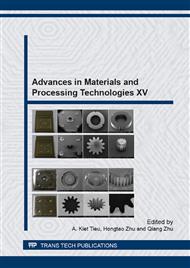[1]
V.B. Ginzburg, Steel-Rolling Technology: Theory and Practice. 1989, New York: Marcel Dekker Inc.
Google Scholar
[2]
W.L. Robert, Strip Shape: Its measurment and control, in Cold rolling of steel, G.D. Boothroyd, G.E, Editor. 1978, Marcel Dekker: New York. pp.655-716.
Google Scholar
[3]
N. Kiyoshi, et al., High reduction rolling technology on pair cross mill. Nippon Steel Technology Report No.75, 1997: pp.9-23.
Google Scholar
[4]
V.B. Ginzburg and M. Azzam, Selection of optimum strip profile and flatness technology for rolling mills. Iron And Steel Engineering, 1997. 74: pp.30-37.
Google Scholar
[5]
V.B. Ginzburg, Profile and flatness acuators. Rolling Mill Technology Series. Vol. 7. 1993, Pittsburgh, Pa: United Engineering Inc.
Google Scholar
[6]
H. Matsumoto, et al., Development of a pair cross mill for crown control of hot strips. Advanced Technology of plasticity 1984. 11: pp.1372-1377.
Google Scholar
[7]
S. Omori, H. Hino, and H. Goto, Characteristic phenomena observed during rolling by pair crossed mill. Ironmaking & Steelmaking, 1994. 21: pp.465-471.
DOI: 10.1179/030192304225012088
Google Scholar
[8]
S. Omori, et al., Analysis of rolling load generated by pair crossed rolling mill. Ironmaking & Steelmaking, 2004. 31: pp.71-80.
DOI: 10.1179/030192304225012088
Google Scholar
[9]
M. Kitahama, et al., Profile Control of hot rolled strip by work roll shifting (K-WRS) mill. Iron and Steel Engineering, 1987: pp.34-42.
Google Scholar
[10]
Y. Miyai, R. Shimizu, and T. Kawasaki, Modernization and operation of NKK's Keihin hot strip mill. Iron and Steel Engineer, 1991. Nov: pp.35-40.
Google Scholar
[11]
Z.Y. Jiang, et al., strip shape analysis of asymmetrical cold rolling of thin strip. Advanced Material Research, 2010. 97-101: pp.81-84.
DOI: 10.4028/www.scientific.net/amr.97-101.81
Google Scholar
[12]
Z.Y. Jiang, D.B. Wei, and A.K. Tieu, Analysis of cold rolling of ultra thin strip. Journal of Materials Processing Technology, 2009. 209: pp.4584-4589.
DOI: 10.1016/j.jmatprotec.2008.10.035
Google Scholar
[13]
Z.Y. Jiang, H.T. Zhu, and A.K. Tieu, Analysis of asymmetrical rolling for cold rolling due to roll edge contact. Key Engineering Materials, 2004. 274-276: pp.715-720.
DOI: 10.4028/www.scientific.net/kem.274-276.715
Google Scholar
[14]
V.B. Ginzburg, High-Quality Steel Rolling: Theory and Practice. 1993, New York: Marcel Dekker Inc.
Google Scholar
[15]
T. Nakanishi, et al., Application of work roll shift mill (HCW-mill) to hot strip and plate. Hitachi review, 1985. 34(4): pp.153-160.
Google Scholar


